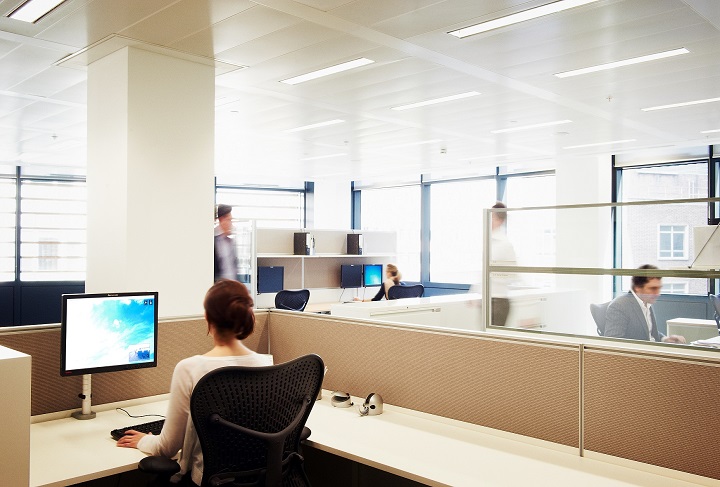Why modern law firms should adopt 'preference-based' workplace designs
Head of Workplace Consulting Giuseppe Boscherini explores 'open plan working vs closed plan office' space in the context of the modern law firm and how a young, adaptive generation of legal professionals is shaping firms' workplace design to better serve clients and carry out daily tasks.
8 minutes to read
Several years ago, in advising the Financial Tax law firm CMS Cameron McKenna on adopting agile working practices in Bristol, I came across an existing office that over two separate floors had adopted, for historical and operational reasons, both open plan and enclosed office planning models.
During interviews most occupants felt very strongly about relinquishing the environment they had become accustomed to and extolled the virtues of each.
We are creatures of habit.
The social construct of the workplace is built on habits - good and bad - which are in effect the unspoken protocols of the manner in which we perform work.
That is a fact. Not always a pleasant or desirable one though and one that is often confronted as a problem.
"Solutions have ranged from fully open plan models as seen at Pinsent Masons, Speechly Bircham and Reynolds Porter Chamberlain through to more cellular solutions as seen at Norton Rose and Mayer Brown."
That is perhaps why HR departments all over the world have been busy adopting psychometric tools that help them understand behavioural profiles of staff they hire, with a view to create cohesive teams of complementary skills.
The role that the workplace may have in supporting such alignment of individual behavioural profiles and work activity has been the subject of much debate in all sectors of business.
The case for a business-supportive environment has been particularly pressing in the light of recent push and pull factors.
And the legal sector is under pressure to change from both push and pull factors. These are:
Push
- Escalating pace of change demanding a high rate of expensive churn
- Pressure on operating costs
Pull
- Emphasis on developing firms’ intangible assets
- Changes in worker demographics
- Demand to think more responsibly about firm’s impacts on the environment
Dramatic changes have taken place in the legal sector which have meant that the relative comfort the profession has enjoyed in terms of preserving generous and codified workplaces has had to give way to new models. Significantly, chief among these changes are:
- The integration of work and life and the ensuing flexibility have had significant impact on traditional legal workplace relationships, especially the attraction, retention and contribution of talented legal professionals
- The dominant barrier to change is an ethos of long work hours that disenfranchises those lawyers that seek flexible work arrangements.
However, the conversation seems to have concentrated rather narrowly on a planning dilemma - open plan or enclosed or traditional office? - resulting in fierce and entrenched positions on both sides.

Most lawyers work in predominantly quiet environments in which to concentrate
Both sides of the argument can be summarised as follows:
Open Plan:
“Open plan offices offer social interaction and social support” - David Holman of the Institute for Work Psychology at the University of Sheffield.
The traditional concerns about privacy, confidentiality and the need to concentrate have not gone away while the issue of fully digital - in the Cloud - document management and information retrieval has yet to be fully resolved.
However a generation of IT-savvy young lawyers, together with issues of team working and more effective company-wide communication, have called into question the true benefits of cellular, some would say insular, working, beyond status and territory.
Some legal firms such as global giant DLA Piper, but also some UK leading names, have been quick to adopt new working practices and have embraced with them the necessary technology and policy changes.
Reed Smith’s office in Broadgate Tower accommodates 630 lawyers across 160,000 sq ft and is intended to promote increased contact and communication between lawyers across practice areas to better serve clients in this way.
Most lawyers work in predominantly quiet environments in which to concentrate, but each of the 12 floors has several break-out spaces in which to gather in order to exchange ideas or work on shared assignments.
Other recent solutions have ranged from fully open plan models as seen at Pinsent Masons, Speechly Bircham and Reynolds Porter Chamberlain through to more cellular solutions as seen at Norton Rose and Mayer Brown, where dual occupancy offices are provided, to hybrids such as Eversheds, with a frontless cellular layout, and the more collaborative fee earner model of Addleshaw Goddard, where workstations are arranged in discrete reconfigurable groups.
Enclosed Offices:
Defenders of the open plan promote their sociable aspect.
But open offices were not designed with workers’ welfare in mind. They remain popular because they allow the maximum number of people to be accommodated per square metre of floor space. The supposed benefits of collaboration are more about improving efficiency and productivity than people’s enjoyment of their workspace.
Most of the North American legal practices have half-heartedly experimented with the open model, fearing a partner mutiny, only in order to swiftly retreat back to the familiarity of a cellular arrangement.
Key arguments raised in favour of traditional enclosed office planning are familiar but nonetheless important and have been:
- The Senior/Junior Partner mentoring relationship that is best nurtured in the intimacy of an enclosed office
- Status and the openly acknowledged relationship, in some firms, between career promotion and certain benefits, including the notorious 'corner office'
- Confidentiality and the avoidance of disturbance when concentrating on reviewing and preparing casework. When it comes to acoustic confidentiality, amongst the top concerns in legal planning are the inability to have enough quiet, to concentrate and to lead confidential discussions
My own experience on the uptake of open plan vs. traditional workplace settings across legal firms in the UK is that, in the first instance, the evidence supporting the arguments in favour of cellular or traditional is flimsy and anecdotal; can one unequivocally link workplace planning to performance?
It seems to me that the focus of the conversation is too narrow and misleading. Indeed, in other sectors talk is currently of a bespoke yet flexible meshing of work settings with work activities, called Activity Based Working, Real Time Working or even Co-Working.

Other recent solutions have ranged from fully open plan models as seen at Pinsent Masons, Speechly Bircham and Reynolds Porter Chamberlain through to more cellular solutions as seen at Norton Rose and Mayer Brown
I prefer to call it 'Preference Based working', the premise behind which is a more dynamic and nuanced way of thinking about workplace and the recognition that knowledge exchange operates in a particular manner.
A 'preference-based workplace' will accommodate a variety of settings that are uniquely indispensable to conducting all of the moments of business that make up a day's work - from meeting a client, through to reviewing a case and carrying out mock court proceedings, to coaching and mentoring.
The answer lies in compiling, in the first instance, a bespoke menu of options and to allow, over time, for such stage-sets of activity to mutate, transform and adapt according to changing needs.
On a typical (single-aspect) floor plate, the correct balance between open plan and cellular layouts would yield greater daylight penetration, a variety of workspaces and an environment more conducive to social interaction.
It’s not so simple however.
My analogy is with Audiophilia - a nuanced approach to the enjoyment of music that identifies a certain output with a particular combination of music reproduction components. Audiophiles are very particular and knowledgeable about the science that combines to produce the desired effect in the rendition of opera voice, chamber orchestra or rock'n'roll piano.
So too, in the world of workplace design.
Thorough brief taking and awareness of the correlation between business practice and the spaces that support and the output will be the spatial equivalent of an audiophile's pipe dream.
The essential nature of legal work is team-based and collaborative. Case teams assemble, work intensely for a period of time, disband and re-form, as part of the normal work process.
Hence, over the course of a single day, work between several individuals may begin in a private office and migrate to the case room, the litigation room or eventually the courtroom. In short, work flows across the team and across the spaces that support it.
Furthermore, shifting practice groups bring together lawyers with diverse specialties to address a common problem.
Law firms still differ significantly from region to region, reflecting the nature of their client base, but their work settings increasingly reflect the need to maximise use efficiency through new technologies and collaborative ways of working.
Legal workspace should be accordingly adaptable and feature a diverse menu of work settings, perhaps fewer fixed workstations, more flexible and adaptable meeting spaces, space for touchdown and probably a greater range of seating options.
Indeed the design of the workplace plays an important role in supporting a versatile approach to practising law, through:
- Assigned meeting project spaces where teams work in a non-residential project space for the duration of the project
- Group scheduled meeting spaces, where teams working mostly at corporate locations, meet in scheduled conference rooms
- Co-located team spaces incorporating collaborative and individual workspaces within team boundaries
- Shared special areas such as project rooms, video-conferencing, training rooms and libraries
- Virtual spaces for teams collaborating mostly through the use of technology
In summary, a formulaic approach to legal planning does not hit the mark and, to use another cliché, one size does not fit all.
What is needed is a balanced workplace that adopts a more task-based approach to space allocation and offers varying degrees of enclosure.